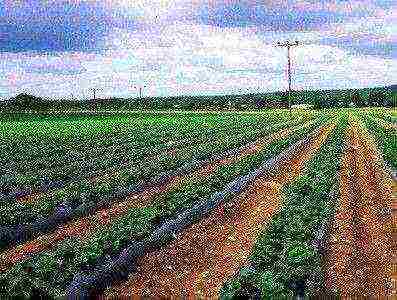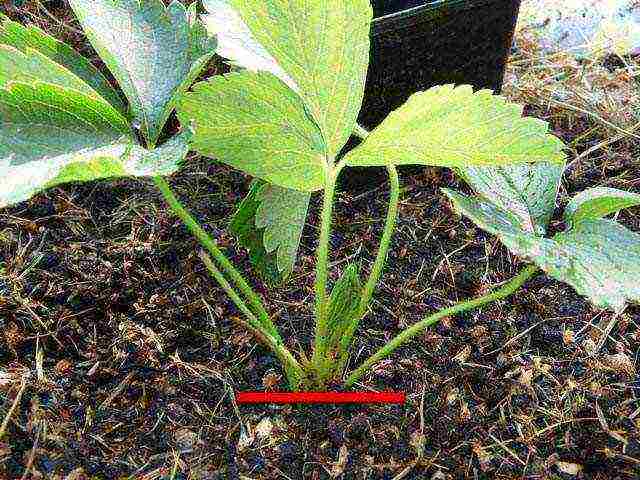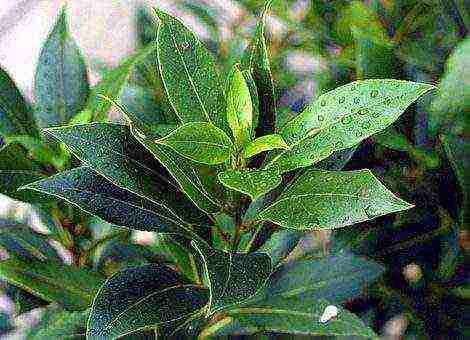Content

Many people love large sweet berries - garden strawberries, popularly called strawberries. When planting a strawberry plantation in the country, the gardener must clearly know the agricultural technology of this culture. For example, the answer to this question:
How many years is it recommended to grow strawberries in one place?
Experienced gardeners say that 3-4 years is the age limit for a strawberry bed. This is due to the aging of the roots, starting from the age of three. New roots that form near the apical buds above the soil surface are exposed to unfavorable conditions and cannot replace old roots.
A good exercise is hilling strawberry bushesstarting from the 3rd year of life. They do this after harvesting, combining with the first post-harvest loosening, but care must be taken that the heart is not covered with earth. You can rejuvenate strawberries by cutting off the aerial portion at soil level. At the same time, new shoots are formed from the dormant and lateral buds of the rhizome, from the base of which new adventitious roots grow. In favorable weather, the aboveground part grows back in 10-15 days. In dry weather, watering is necessary.
Rejuvenate strawberries immediately after fruiting. Caring for rejuvenated plants consists of loosening the soil, weeding and fertilizing. Do not confuse strawberry rejuvenation with leaf mowing. After mowing, only the leaves are renewed. Mowing does not affect the development of the root system. Rejuvenation is carried out in 1-2 years. But there are other opinions on the timing of growing strawberries in one place. Amateur gardeners from Latvia offer to grow strawberries as an annual crop. First of all, early varieties are suitable for this, but varieties of medium ripening can also be used. Strawberries are planted in a garden bed in three rows at a distance of 40 cm between rows and 15 cm in a row no later than the first days of August. Arches for shelter are installed along the bed.
In early spring (when the snow has not yet completely melted), the aisles are covered with a black film (roofing material or other mulch can be used), and a transparent film is stretched over the arcs. If the temperature rises in the shelter above 20 degrees, the film is raised from below. When the strawberries begin to bloom, the film lifts. And protected from the wind, bees and other insects are more active. In addition, pollen does not get wet in rainy weather (do not forget to water the plants on time). True, the soil retains moisture under the mulch, and watering, accordingly, should be carried out quite rarely. The value of mulch is not limited to economical consumption of moisture. It is impossible for weeds to break out from under it, the soil retains its structure (no need to loosen it), the bed retains heat better, the berries are always clean, almost do not get sick with black rot.
But back to growing strawberries with an annual crop. The entire crop is harvested almost until July. After that, you need to remove the black film. If there is mulch made from leaves, sawdust, etc., then it should be raked to the sides. Discard the central row plants. After abundant watering of the beds and loosening of the central part, the whiskers of the side rows are placed in this free zone.As soon as the young rosettes take root, and they take root rather quickly, especially if they are watered, dig out the remaining two side rows. And young grown sockets are planted in a prepared place. By autumn, young strawberry plants have enough time to form in order to give a full harvest. There is a very interesting experience of growing strawberries in one place for over 20 years. This is achieved by using leaf humus.
This fertilizer is prepared in the fall. During leaf fall, the leaf is collected, folded into heaps, sprinkled with ash and superphosphate, then covered with tar paper and allowed to “ripen” until next fall. Twice a year, strawberries are mulched with leaf humus: in early autumn and early in spring. At the end of August, after removing the beveled strawberry leaf and loosening the soil, a layer of mulch of 3-4 cm is poured around each bush.Autumn mulching serves not only as a fertilizer, but also as a heater for the winter, and in spring does not allow the roots to be exposed. At the end of April, strawberries are processed in the same way as in autumn. This helps to retain moisture in the soil. In a loose nutrient medium, strawberries grow many young roots. It rejuvenates, bears fruit abundantly, does not form a powerful leaf apparatus and a large number of mustaches.
I want to share with readers my personal home-grown method of planting strawberries.
The use of this method makes it possible to grow strawberries in one place for up to 6 years, without reducing its yield and without losing its large-fruited.
Planting strawberries
First, a ditch is dug 40 cm deep, 160 cm wide and 400 cm long.
Then it is stuffed with grass to the top - with a hillock. I trample it well, tamp it, add more herbs, dry or fresh (when rotting, the grass gives heat and emits carbon dioxide, which is very useful for the growth and development of strawberries).
Reference by topic: Large-fruited strawberries: varieties and care all year round
I throw the hose onto this garden ditch and fill it with water. I pour earth on top and fill it with water again. Then I sprinkle a mixture of humus with ash on top, about 20 buckets.
In no case should lime and fresh manure be added, as this causes rapid growth of tops and leaf spot.
So, we got a bed 35 cm high. It is very convenient for planting early berries. I cover the finished bed with a film and leave it alone for two weeks to shrink. When planting strawberries, I maintain a distance: between bushes - 40 cm, between rows - 80 cm. In row spacings I plant garlic (spring or winter) and onions on a feather.
I plant strawberries either in April or in August. My neighbors, watching me dig a ditch, were surprised at first, but when they saw what kind of crop I was harvesting (some berries did not fit in a glass!), They began to ask for bushes for seedlings.
Strawberry care
Now about leaving. Watering - only at the root, because sprinkling causes gray rot. After watering, I often use grass mulching. During fruiting, so that the strawberries are sweeter, I slightly reduce the watering.
The next year in the spring, as soon as the snow melts, I remove the leaves and feed them with ash - 2 tbsp. l. under the root, and be sure to loosen. Then I spray it with potassium permanganate, and a week later with a decoction of garlic and onion husks. From time to time I cut off my mustache.
Reference by topic: Strawberries under cover - how is it right?
In August, when there is an active laying of flower buds for the next year, I again remember my motto and water abundantly. I repeat this watering in October, if there is no rain, so that the strawberries can endure the winter well. In the third year of planting, I install drip irrigation.
In November, I cover the strawberries with twigs that remained after pruning the remontant raspberries, which I always cut to the very root before winter. For the first two years I cover young plantings of strawberries with fallen leaves from frost.
During the winter, the foliage is compressed and remains for the next year as mulch and fertilizer, thereby rejuvenating the earth and inhibiting the growth of whiskers, and also promotes the rooting of young roots.This method of planting and caring for strawberries saves the gardener from frequently changing the place where strawberries are grown (up to 6 years old}) I wish you all good luck!
Below are other entries on the topic "Cottage and garden - do it yourself"
Top dressing for strawberries: Fertilizing garden strawberries If garden strawberries ... So that strawberries yield a harvest every year: professional advice: So that strawberries are not translated So that berries ... Elizabeth strawberries for the Middle Lane and the North: Strawberry variety Queen Elizabeth - ... How to plant and care for strawberries (strawberries) varieties Gigantella: Growing and caring for strawberries ... Harvest of strawberries a year after planting: Growing strawberries - the first harvest Oh ... Autumn planting of strawberries: How to plant strawberries in autumn Autumn planting ... Planting strawberries in August: August propagation of strawberries Not far away ...
Subscribe to updates in our groups.
Let's be friends!
When my parents got a summer cottage in a "wild" field, the first thing my mother planted on it was strawberries. It was a long time ago, but I still remember the event very well, because it was for me at that time a real adventure and by no means easy. The site was very far from the city (buses with transfers, and a couple of kilometers on foot), there was no water, and there was a terrible scorching heat.
 Today I can say with a serious air that garden strawberries are not planted this way. But then we planted. In a dry, hardly "hollowed out" bed. Yes, yes, the earth was as heavy as a stone, and the word "dig up" cannot be used even with a stretch. We brought a bucket of water from a nearby village, which is a kilometer from our dacha. How much did each bush of this water get? Oh yeah, literally a glass. That's all. Incredibly tired and exhausted by the heat, we left. Our strawberry remained, open to all winds, under the scorching sun. But, as a child, I was sure that we did everything as it should, no less.
Today I can say with a serious air that garden strawberries are not planted this way. But then we planted. In a dry, hardly "hollowed out" bed. Yes, yes, the earth was as heavy as a stone, and the word "dig up" cannot be used even with a stretch. We brought a bucket of water from a nearby village, which is a kilometer from our dacha. How much did each bush of this water get? Oh yeah, literally a glass. That's all. Incredibly tired and exhausted by the heat, we left. Our strawberry remained, open to all winds, under the scorching sun. But, as a child, I was sure that we did everything as it should, no less.
Then my memory changes me, but I remember that we always had a lot of strawberries, which I was insanely happy about - I remember that again. But whether our first bed survived, apparently, then I did not care much, no matter how ashamed I was to admit it now.
It just so happened that almost all of us call "strawberries" garden strawberries or pineapple strawberries. And somewhere it is customary to call it "Victoria". Here is such a "confusion" with the name of our familiar and beloved by all from childhood berry. I don't see anything so terrible in this and I continue to call her in life - strawberries, with this I grew up.
Garden strawberries (Large-fruited strawberries, pineapple strawberries) are a perennial plant of the Pink family. Winter hardiness is weak, in snowless winters, freezing of plants occurs already at -10⁰С, at a temperature of -20⁰С they die. The root system is superficial, which is why strawberries are not drought-resistant, at the same time they are sensitive to excess moisture. The plant is shade-tolerant, but at the expense of yield. Propagated by numerous creeping shoots - whiskers, less often - by seeds (varietal characteristics are not preserved), and in some cases - by dividing the bushes.
Correct planting of strawberries.
I want to note right away that the expression “planted and forgotten” is not at all about strawberries, no matter how sad it is sometimes. However, the payment for our care and attention is more than worthy. There are few people who are indifferent to this aromatic, tasty, very healthy and beautiful berry.
Landing dates.
When is the best time to plant strawberries? .. The best time for planting is the first half of May (from 1 to 15), the end of July and August. Basically, the recommended final planting dates are September 15th. But I always try to land her no later than August. In general, my favorite time is from the second half of July to mid-August. Then my strawberry has time not only to take root, but also to build up a good root and green mass, that is, excellent healthy bushes, which means that it is completely ready for wintering and subsequent fruiting.
I understand that it is not always possible to adhere to such “ideal” dates, especially when it is the first time to plant strawberries. But still - the earlier we plant the plants, the better it will bear fruit next year. By the way, seedlings with a closed root system, that is, in separate pots, can be planted during the entire growing season, but still no later than September 15th.
Landing site.
If possible, you need to decide on the landing site in advance. It must be well lit and ventilated... Areas in the shade, in lowlands, flooded with water are categorically unsuitable. If the area is wet, then strawberries are best grown on slightly raised ridges, which is exactly what I do. And so that the edges of the beds do not crumble and weeds are less annoying, I fence them with a board.
Selection of predecessors is also of great importance. You can not plant it after tomatoes, potatoes, peppers (other nightshades), cucumbers, and after flowers from the families of buttercups and Asteraceae, and generally undesirable after any perennials that have grown in this place for more than one year. The reason for this is common pests and diseases to which strawberries are very sensitive. But garlic, onions, legumes, parsley, and other green crops will be good predecessors for it. In the place where the strawberry itself grew, you can return it no earlier than five years later.
❗ Never plant garden strawberries next to raspberries. Such a planting will come in handy for the strawberry-raspberry weevil, and you will lose a lot of energy and time to fight it, while simultaneously giving a considerable part of the berry harvest to the pest.
How many strawberries can you grow in one place?
Most often, garden strawberries are grown in one place for 3-4 years. But it so happens that someone grows less (2-3 years), and someone, moreover successfully, more (up to 8 years). What does it depend on? First of all, from our desire, but then, probably, from the possibilities. The fact is that pathogens and all kinds of pests accumulate very quickly on the beds with strawberries. And keeping plants in one place for more than three years, without an obvious loss of yield, is possible only with very, very careful care: timely treatments and protection from pests and diseases, regular feeding, keeping them clean from weeds and without thickening the plantings.
Soil and fertilizers.
We carefully prepare the soil for planting garden strawberries, dig up, choosing all the roots of weed vegetation, even the smallest, especially wheatgrass. The earth should be cleared of them as much as possible. Because the fight against weeds in strawberries is another story, and it is imperative to fight them, strawberry beds, like no others, need cleanliness, in any sense of the word.
All fertilizers, organic and mineral, I apply only for the previous crop. Or, if this is a freshly dug area, then it would be good to fertilize it in advance, at least two weeks in advance: add a little compost or humus (by no means fresh manure), you can use a special fertilizer for garden strawberries. Although, if the soil itself is nutritious enough, you do not need to add anything. But directly under the planting of plants, in the holes, I do not apply any fertilizers.
Usually, when planting winter garlic and choosing a place for it, filling the bed, I already plan that later, I can use this bed primarily for strawberries. It is very convenient. It is released at the most appropriate time and a wonderful predecessor turns out. Before planting strawberries, I mulch this bed with dry grass, then I simply move it apart in the place where the hole will be, and after planting the seedlings, I move it back. You can also plan and plant early greens, as a precursor for strawberries.
Landing technology.
So, the time and place were chosen, the garden was prepared, the mustache was bought, the seedlings were bought, they were taken from a neighbor, in general, they were obtained.If potted seedlings are great, they are easier to plant and require less maintenance after planting. But it is far from always possible to get seedlings of the desired varieties in this form. Strawberry bushes with an open root system, before planting, I soak in a weak (!), Pale pink, potassium permanganate solution, just pour it into a basin and let the strawberries float in it for half an hour. If the seedlings are of completely "dubious" origin and quality, then you can rinse them with this product: 3 tablespoons of salt + 1 teaspoon of copper sulfate per 10 liters of water, for 5-10 minutes, then be sure to rinse with clean water. All flowers and buds on the bushes should be cut off - they will take a lot of strength, weaken the plants, but we do not need this.
Disembarkation is best done in the evening, and in cloudy weather at any time of the day. The soil must be well moistened. It is advisable to mark the bed with a cord. The most convenient, it is also the most common, the planting scheme is two-line, especially if you use raised ridges. Between the rows, I am not stingy, leaving a distance of 50-60 cm, and between the bushes in a row - 20-30 cm. At first it may seem that the bed is half-empty, but this is only at first ...
Then we look at the roots of the seedling and dig a hole in the designated place. If the roots are long enough, then the hole should be deep enough, since we will plant, carefully straightening the roots so that they do not stick out, bent up, do not intertwine in a ball and are not compressed into a lump. You can make a mound at the bottom of the hole and spread the roots over it. But in general, root length more than 10 cm, it is advised to cut... Another, perhaps the most important point is the planting depth. We carefully make sure that the growth point, the so-called "heart" of the bush, is not buried, otherwise it will mate, as well as not be raised above the surface of the earth, then it will dry out, respectively, in both cases, the whole plant will die.

Immediately after planting each individual bush, we compact the soil around with our hands so that there are no voids at the roots, and water it abundantly from a watering can, preferably with a nozzle.
After all the seedlings are planted in their places, the garden bed can be mulched (cut grass, straw, peat, in general, which is more accessible), this will retain moisture in the soil and prevent it from overgrowing with weeds, at least for a while. If sunny weather is expected ahead, although, even if it is not expected, but what if it happens, we need to throw light covering material on our new plantings, especially if we planted in spring or in July. Then, closely monitor soil moisture for two weeks. It would be nice, if possible, to water the planted strawberries for the first five days - every day, unless, of course, it rains. In the case when pot seedlings were planted, then the covering material is not needed, it is enough to shed the soil well after planting, and then as needed, but far from so often than those plants that are planted with open roots.
It may happen that suddenly after planting, an incredibly hot, or, on the contrary, unusually cold weather will come out, and some of the leaves of the plants will suddenly turn red. Do not be scared and run after "medicines", they did not get sick, this is just a reaction to weather conditions.
Author of the article: Candy.

Everywhere they write that it is necessary to keep strawberries in one place for three or four years, and I have it growing since 1974. I wanted to dig up a plot in the fifth year, but changed my mind. She harvested, weeded out the plantings, fertilized with nitrophosphate, processed the soil around each bush and covered the aisles with humus. And the next year (the summer was warm, dry), the Komsomolskaya Pravda received a harvest in terms of a hundred square meters, and Festivalnaya - 150 kg. This is an excellent harvest from seven- to eight-year-old plants. Maybe those who do not have the opportunity to establish a new plantation after four years of exploitation will try to do as I do.
A. Alekseeva, g.Lipetsk ("Household economy", 1983, No. 2)
How many years can you keep strawberries in one place?
Depending on varietal qualities, the optimal period is 3-5 years. It also depends on the condition of the bushes. There are known cases of good fruiting for 20-30 years with the so-called carpet placement. Old plants are removed, leaving young plants within the same area. With this method of cultivation, a continuous leaf canopy is formed, contributing to a better overwintering. It is most useful in harsh conditions.
The limited size of the plots does not always allow for the necessary crop change. You have to keep the strawberries in one place for much longer than the recommended periods. In this forced case, you can rejuvenate the planting in the following way. First, they give the opportunity to freely grow mustache in the aisles, watering and feeding them as necessary. Then the rows of old bushes are uprooted. Instead of them, empty aisles remain, and new rows are formed from young mustaches. In this way, you can gradually move the strawberry section, directing the mustache to a new place and separating it from the old mother bushes after good rooting.
Of course, this method is applicable if the strawberries are healthy, not affected by dangerous pests and diseases.
"Your Garden"
About strawberries
Strawberries are constantly renewing their leaves. Moreover, in a wave-like manner, one wave replaces another. The first is celebrated in the spring, as soon as the snow melts. But now harvest time is approaching, and the plant is being rebuilt before our eyes. It spends all its nutrients mainly on fruiting. The harvest is harvested, and again all forces are switched to the formation of new leaves, and then flower buds. By the way, the undulating development is inherent in the root system of strawberries. In the spring, the roots start to grow. The first wave of growth ends at the time of flowering of strawberries and slows down altogether during fruiting. Harvested - and the second wave of root growth begins. It usually lasts until mid-September.
"Household economy", 1984, No. 1
Read also:
Discuss the article on the forum

